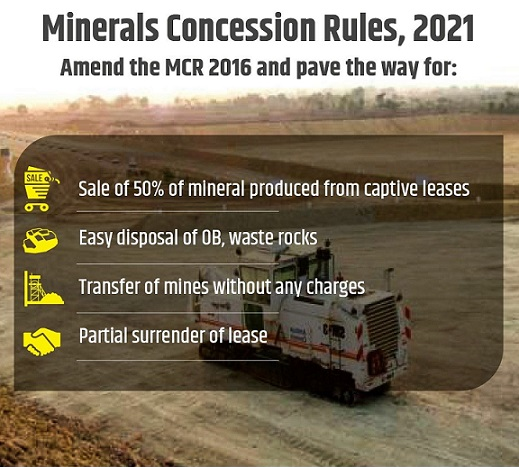Minerals Concession (Fourth Amendment) Rules, 2021 | 11 Nov 2021
Why in News
Recently, the Ministry of Mines has notified the Minerals (other than Atomic and Hydro Carbons Energy Mineral) Concession (Fourth Amendment) Rules, 2021.
- It will amend the Minerals (other than Atomic and Hydro Carbons Energy Mineral) Concession Rules, 2016 [MCR, 2016].
Key Points
- Amendments:
- Sale from Captive Leases:
- New rules inserted to provide a manner of sale of 50% of minerals produced from the captive leases.
- With this amendment, the way for releasing of additional minerals in the market by greater utilization of mining capacities of captive mines has been paved.
- Captive mines are those that produce coal or mineral for exclusive use by the company that owns the mines, while non-captive ones are those that produce as well as sell the fuel.
- Disposal of Overburden (OB):
- Provision added to allow disposal of overburden/ waste rock/ mineral below the threshold value, which is generated during the course of mining or beneficiation of the mineral.
- This will enable ease of doing business for the miners.
- Area for Grant of Mining Lease:
- Minimum area for grant of mining lease has been revised from 5 ha. to 4 ha. For certain specific deposits, minimum 2 ha. is provided.
- Part Surrender for all Cases:
- Part surrender of mining lease area allowed in all cases.
- Earlier, part surrender was allowed only in case of non-grant of forest clearance.
- Transfer of Composite Licence:
- Rules amended to allow transfer of composite licence or mining lease of all types of mine.
- Sale from Captive Leases:
- Objective:
- To increase employment and investment in the mining sector, increasing revenue to the States, increasing the production and time bound operationalisation of mines, increasing the pace of exploration and auction of mineral resources, etc.
Mining Sector in India
- About:
- India holds a fair advantage in production and conversion costs in steel and alumina. Its strategic location enables export opportunities to develop as well as fast-developing Asian markets.
- India is the world's second-largest coal producer as of 2021.
- India is the world's second-largest crude steel producer, as of 2020.
- India has the same mineral potential as South Africa and Australia. It produces 95 types of minerals but despite this huge mineral potential, the mining sector of India still remains underexplored.
- The mining sector contributes around 7 to 7.5% of the GDP of countries like South Africa and Australia whereas it is only 1.75% in India.
- 11 states account for 90% of the total number of operational mines (Andhra Pradesh, Odisha, Chhattisgarh, Jharkhand, West Bengal, Maharashtra, Tamil Nadu, Gujarat, Madhya Pradesh, Rajasthan, and Karnataka).
- Constitutional Provision Related to Mining:
- The entry at serial No. 23 of List II (State List) to the Constitution of India mandates the state government to own the minerals located within their boundaries.
- The entry at serial No. 54 of List I (Central List) mandates the central government to own the minerals within the Exclusive Economic Zone of India (EEZ).
- The central government has the ownership over all offshore minerals (ie, minerals extracted from the sea or ocean floor in the Indian maritime zones such as the territorial waters, continental shelf and exclusive economic zones).
- Related Schemes:
- The National Mineral Policy 2019.
- Initiatives are being taken to ensure early operationalisation of auctioned greenfield mineral blocks.
- Rationalisation of taxes in the mining sector is also being considered.
- Under the Atmanirbhar Bharat scheme, enhancing private investments in the mineral sector and bringing in other reforms has been announced.
- District Mineral Foundation Funds.

